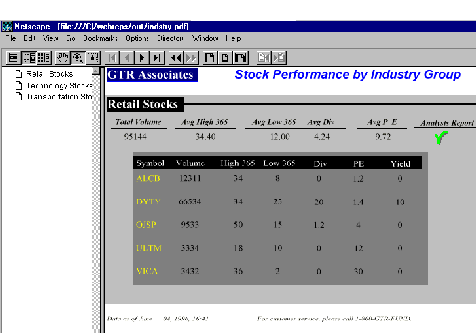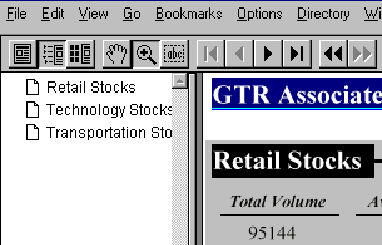
Web Publishing Using
Developer/2000
Summary:
The World Wide Web has
created an enormous opportunity to disclose corporate information
on an internet and intranet scale.
This paper discusses how
your existing Developer/2000 applications can leverage this
opportunity without changing any code.
Delivering Corporate
Data on the WEB.
The recent release of
Developer/2000 for Windows 95 and WindowsNT, supports Adobe's
Portable Document Format (PDF) , an emerging standard for
delivering high quality documents on the World Wide Web. This
allows for the creation of high fidelity reports. Existing
reports are automatically supported, even reports with embedded
charts.
Developer/2000 also
supports the ability to export standalone charts and displays to
the formats supported on the World Wide Web (for example PICT,
GIF) meaning that any chart or graphic can be deployed.
Upcoming releases of Developer/2000 will further leverage the capabilities of the World Wide Web. In the next major release of Developer/2000 (Release 2.0), we will address performance of applications by allowing Reports and Charts to run anywhere (any server). Webserver support will be added to all the Developer/2000 components. This will allow the deployment on the World Wide Web of Interactive applications built using Developer/2000 components,
This paper discusses the
benefits for corporations that are able to create compound
documents using the Reporting and Charting components of
Developer/2000 today. These documents can be deployed in either a
standard Client-Server configuration or without any changes, can
be made accessible to users with a web browser such as those from
Netscape, Microsoft and Oracle.
Accessing Corporate
Data.
Until today corporations
have had no easy way of addressing the enormous need for
information inside the corporation (Intranet), as well as
customer or employee access to information from anywhere in the
world (Internet).
Solutions varying from
accessing textual data in 'bulletin board' like applications, to
distributing postscript viewers have been applied without much
success.
The World Wide Web is the
right way to address the problem. Dynamically and statically
created pages existing on WEB servers allow inexpensive or 'thin'
clients, (386 PC's or the Network Computer), access to all of the
information for the corporation via any popular web browser
(PowerBrowser from Oracle Corporation or any other Netscape
compliant browser)
This allows organizations
to start publishing information as a service to customers and
employees. Employees can now access corporate information
enabling them to answer questions or provide information
independent of location and timezone.
How are pages being
created today?
Today the most commonly
used authoring environment is an old fashioned editor.
Editors allow for quick
solutions, but as the amount of information increases, the
maintenance will become ever more difficult and it will become
almost impossible to ensure consistency between different
applications.
Other solutions require the
use of multiple tools, not allowing any control over pagination,
cross references, page numbering etc.
many developers are turning
to C++ or Visual Basic applications to have complete control, and
then end up creating and maintaining code.
Perhaps the biggest
drawback is the fact that published information is by definition,
generic. It is not possible to retrieve information on demand
from corporate information systems as people are used to doing
when working in the office.
Corporations need an
authoring environment with the ability to deliver solutions fast
and directly to the World Wide Web, yet providing easy
maintenance.
What is the quality
solution to delivering information on the World Wide Web?
The real solution is to
enhance existing authoring environments with World Wide Web
support as well as controls within the development environment to
support the wide range of new features that the WEB allows. This
should be done in a way that is transparent to the application
developers allowing a smooth integration of corporate
applications and World Wide Web deployed applications.
Developer/2000's approach
to delivering a single application on many diverse platforms such
as Windows 3.1, Windows95, WindowsNT Macintosh, Motif and
Character mode is already unique in the marketplace. With the
additional WEB enabling features the applications can truly be
delivered everywhere, including the World Wide Web.
Applications generated from
Designer/2000 can automatically be WEB enabled. This delivers
smooth integration, easy maintenance and manageability for
applications regardless of their deployment platform.
What can be accomplished
with this release?
Any report or chart already
developed can be deployed on the web with a simple re-run of the
application generator. Additional WEB features can be added with
very little (or no) coding at all.
WEB Features include:
What is needed to add
web features to your existing applications for the?
In this release of
Developer/2000 WEB features have been implemented using PL/SQL .
In Release 2.0 of Developer/2000 these controls will become
properties easily controlled from the properties Palette,
(eliminating all coding requirements) as well as accessible
through PL/SQL (conditional control).

Example - Reports WEB
enabled page
In the above report we have
added 3 controls that will all be explained below. Links to
popular URL (Named places on the WEB), Table-OF-Contents as well
as the ability to drill down directly within the data of the
report by clicking on the relevant column.
This example plus many
others are located on the Developer/2000 distribution CD-ROM.
Link to URL/Drill Down
Reporting
URL links can be added to
any layout object (any field, boilerplate, frame etc. This allows
lookup functionality (additional information) directly from
within the report with context from the value of the field. An
example could be to use a value from a stock name field to lookup
the chart of how the stock is performing. Clicking on any value
in the 'Symbol' column will automatically look up that stock
symbol and display a chart on the performance.
Drill Down reporting can be
implemented the same way. Clicking on a summary value in a report
can automatically activate another sub-report to show the
details.
Table Of Contents
The PDF driver allows users
access to a complete index , or table-of-contents, (TOC),
accessible on every page of the output.
Activating the relevant
entry in the TOC by clicking on it, automatically positions the
viewer on the corresponding page in the output file (Clicking on
'Transportation stocks' will position the viewer on the page for
stock information for that category).

Conclusion:
Developer/2000 allows you
to take existing applications and deploy them on the web today.
Not by changing the applications, but by deploying with
absolutely no change to the code.
Future versions of
Developer/2000 will extend these capabilities. All components of
developer/2000 will have tools which allow developers to design a
completely integrated application which can be deployed in a
standard Client/Server configuration and also on the World Wide
Web.
The next major release of
Developer/2000 will support enhanced features for solutions
anywhere (including the WEB), World Wide Web deployment will be
enabled using the powerful Developer/2000 application servers,
allowing transparent remote execution in a three-tier
architecture.
Used together with the
Oracle's Webserver (The reports server can be a Cartridge), total
optimum performance is guaranteed.
Per Brondum
Director Of Product Management
Developer/2000